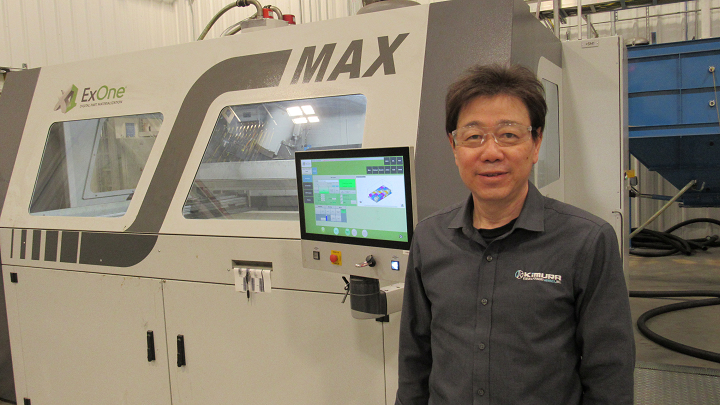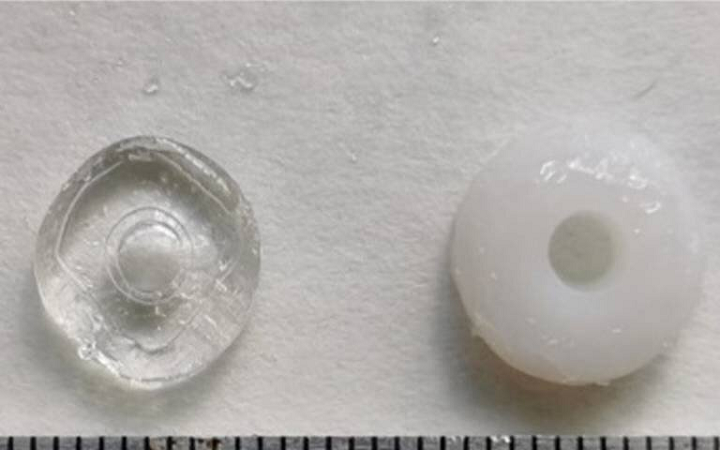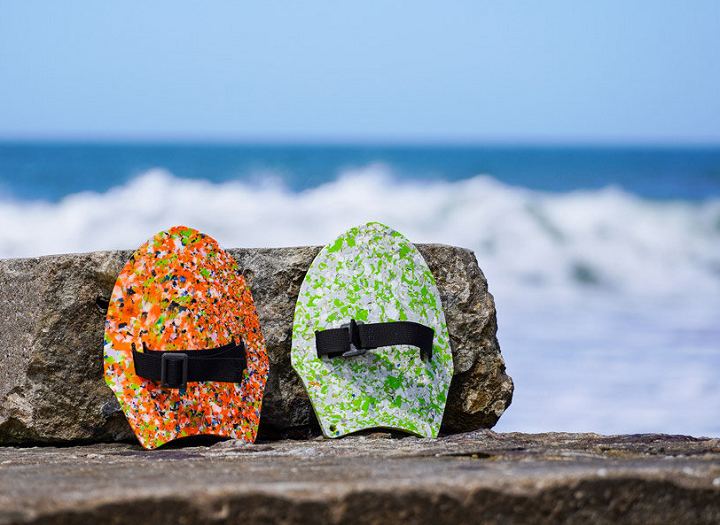We’re starting with business in today’s 3D Printing News Briefs, as Mantle recently announced three collaborations, Stratasys is strengthening its infrastructure in France with a partnership and e-store, and the Kimura Foundry Group has purchased its 10th Desktop Metal sand binder jetting system. Moving on, a European research team reports they can 3D print medicine in less than ten seconds, and the Dubai RTA is using 3D printing to maintain facilities and roads. Finally, a design studio is 3D printing handboards using plastic waste.
Mantle’s Three Collaborations Based on TrueShape 3D Printed Tooling Inserts

Medical forceps tooling inserts with conformal cooling were printed by Mantle via TrueShape technology using H13 Flowable Metal Paste. (Mantle’s 3D printed inserts were accurate within 0.0015″.)
At the recent AMUG Conference and Plastics Technology Expo in Illinois, metal 3D printing technology company Mantle Inc. exhibited the results of three successful tooling collaborations, each of which used its patented TrueShape hybrid metal AM and H13 Flowable Metal Paste. First was Connecticut-based Westminster Tool, which needed to make both cavity and core tooling inserts in order to quickly mold sample parts for medical forceps. The company wanted to mold the forceps from Arkema’s bio-based, glass-filled Rilsan FKZM 65 O TD MED, supplied by Foster Compounds and used for surgical device applications. Mantle’s TrueShape was used to 3D print the tool inserts—designed with conformal cooling channels—in just 86 hours, holding a tolerance of +/- 0.0015”.
Another Connecticut company, Wepco Plastics, designed inserts and conformal cooling channels with Mantle’s TrueShape while molding a stand for a cell phone. After Mantle 3D printed them in 80 hours, the parts were molded in blue and black ABS plastic. Amanda Wiriya, Wepco’s Manufacturing Support Director, reports that they had smooth surface finishes, and came very easily off the tool. Finally, New York-based Precision Laser Technology (PLT) offers laser welding, engraving, texturing, and direct part marking for injection molds and molded plastics, and participated in a study with Mantle to verify that its H13 materials could hold up under machining and welding without having to change these processes. Mantle 3D printed four test bars out of H13, and after precision milling and grinding, the results were, according to the press release, “indistinguishable from traditional H13 tool steel.”
Stratasys Announces New Partnerships, E-Store in France

Stratasys’ new dedicated e-store allows French customers to quickly and easily order from a continually expanding materials and consumables range
Stratasys (NASDAQ: SSYS) has added to its network of partners in France in order to strengthen its sales, service, and support infrastructure in the country. Joining existing partner Seido Systèmes as authorized Stratasys resellers for France are specialist AM solutions resellers Cylaos, Dome Technic Dentaire (DTD), and Halbronn. They will offer customers the necessary industry knowledge and consultation expertise needed to find the best Stratasys solution for their specific application. Stratasys also signed a partnership agreement with Fives, which works in the industrial maintenance sector, for the purposes of improving its ability to offer customers important technical support from its 600-person nationwide team of maintenance technicians. The company also launched a dedicated e-store to give its customers easier, faster ordering of consumables and materials. French customers can choose what they want and place a direct order in just a few clicks, and will also benefit from regular promotions.
Andy Langfeld, President, Stratasys EMEA, said, “We continue to see more and more manufacturers identify AM as an integral solution to their production operations, and this has further intensified over the last two years with supply chain issues deriving from COVID-19.
“The new collaborations announced today, as well as the provision of easier access to our ever-expanding material options, demonstrates our commitment to ensuring that the depth and breadth of our sales, service and support mechanism continues to expand to meet this market need and growth.”
Kimura Foundry Group Buys 10th ExOne Sand 3D Printer from Desktop Metal

Dr. Yoya Fukuda, President of Kimura Foundry America, with an S-Max at the company’s facility in Shelbyville, Indiana.
Japan-headquartered Kimura Foundry Group, which is a worldwide network of foundries that delivers high-quality castings, now owns the largest number of ExOne 3D printers in the world with the purchase of its 10th digital sand 3D printer from Desktop Metal. Traditional casting means waiting nearly 40 days for tooling, but Kimura is a major AM adopter, which allows it to 3D print cores and molds in ceramic sand and create prototype castings in just five days. Kimura invested in its first ExOne sand binder jetting systems in 2013, which caused its revenue to skyrocket because of the design freedom and speed its customers were enjoying. It launched a Direct Molding Process with six ExOne binder jetting printers across multiple Japanese facilities, set up Kimura Foundry America in 2018, and is building a new foundry in Indiana around ExOne’s sand binder jetting. Now, with its recent purchase, Kimura will install its third S-Max platform printer in the US.
“We are honored that Kimura, a foundry company with such high-quality standards, continues to make us their choice for digital casting solutions. Kimura Foundry Group is truly leading the way in production use of additive manufacturing, and they are an important partner in our mission to demonstrate the benefits of Additive Manufacturing 2.0 across all industries,” said Ric Fulop, Co-Founder and CEO of Desktop Metal.
European Researchers 3D Printing Medicines in Seven Seconds
A team comprised of researchers from the University College London (UCL), FabRx Ltd., Universidade de Santiago de Compostela, and Maastricht University’s MERLN Institute for Technology-Inspired Regenerative Medicine published a study on their work developing a new vat polymerization technique for 3D printing medicines in just seven seconds. Vat photopolymerization has a very high resolution for microscale printing, and also doesn’t require high heat, but it’s not very fast. The team figured out a way to print an entire object all at once by shining multiple images of the object, viewed at different angles, onto the resin, resulting in much faster print speed. The amount of light shining down gradually builds up until polymerization occurs, and all points of the 3D object in the resin can be reached at the same time by adjusting the intensity of the light at different overlaps and angles. They demonstrated their work by 3D printing paracetamol-loaded printlets.
The abstract states, “In this work, for the first time, a volumetric printer was used to fabricate drug-loaded 3D printed tablets (Printlets™) within seconds. Six resin formulations were evaluated using this printer, each composed of poly(ethylene glycol) diacrylate (PEGDA) as the crosslinking monomer, lithium phenyl-2,4,6-trimethylbenzoylphosphinate (LAP) as the photoinitiator, and paracetamol as the model drug. Water or PEG300 were included as diluents in varying concentrations to facilitate drug release. Paracetamol-loaded Printlets were successfully fabricated within 17 s. Drug release rates could be tuned by altering the monomer-to-diluent ratio of the photosensitive resin, with a lower ratio releasing drug faster. The present work confirms the suitability of volumetric 3DP for printing drug products in a matter of seconds. Upon further optimization, this novel technology can enable rapid, on-demand fabrication of medicines and medical devices.”
Dubai’s RTA 3D Printing Spare Parts to Maintain Roads & Facilities
The Dubai Roads and Transport Authority (RTA) has a new solution to maintain its roads and road facilities. The agency is using 3D printing to fabricate needed spare parts for cladding materials and electromechanical systems used for this maintenance. The CEO of Traffic and Roads Agency for the RTA, Eng Maitha bin Adai, recently reiterated how important it is to keep up with innovative systems and technologies, and using 3D printing to manufacture these spare parts will also help Dubai RTA realize the government’s overall 3D printing objectives. The Traffic and Roads Agency worked with three 3D printing companies for this initiative.
bin Adai said, “During the past few months, RTA developed a new initiative and conducted various studies and experiments to increase the availability of spare parts for roads maintenance systems, in cooperation with specialist 3D printing companies. The initiative has proved to be successful in extending the sources of spare parts such as propeller fans, control equipment, and cladding for tunnel walls in Dubai’s road facilities.
“As part of the initiative selected types of spare parts were chosen to be 3D printed; based on specific criteria, such as the lack of spare parts in local markets and taking into consideration safety measures. The initial results of implementing the technology revealed a 50% saving in the operational cost of purchasing spare parts. Additional improvements were introduced on the factory-based spare parts on account of historical data analysis, which reduced breakdown rates to record-low levels. 3D printing technology also contributed to reducing the cost of transportation and the time needed to import spare parts to Dubai.”
3D Printed Handboards from Plastic Waste
Finally, multidisciplinary design studio Uido has come out with a line of waterboards 3D printed out of plastic waste and old prototypes. The two designers, Lautaro Lucero and Tadeo Lucero, drafted a blueprint of their idea, and after a couple iterations, came up with a fin-like look for the Wabo Handboards. In an effort to reduce waste and create a more green product, they shredded the plastic of discarded prototypes, made 6 mm plates to cut, pressed the plastic into a mold, and attached the handboard’s elastic leash at the top.
“At Uido, each time we do a product design project, it is an essential part of the process to make 3d printed prototypes. so, throughout the year, we fill tons of boxes with those prototypes of different colors and sizes. Our commitment to the planet is serious, and our only waste as a company is those prototypes, so we started thinking about what we can do with them and how we can transform them into a new and fun product. that is how the idea of making handboards for surfing waves was born,” Lautaro Lucero said.
Subscribe to Our Email Newsletter
Stay up-to-date on all the latest news from the 3D printing industry and receive information and offers from third party vendors.
You May Also Like
Precision at the Microscale: UK Researchers Advance Medical Devices with BMF’s 3D Printing Tech
University of Nottingham researchers are using Boston Micro Fabrication‘s (BMF) 3D printing technology to develop medical devices that improve compatibility with human tissue. Funded by a UK grant, this project...
3D Printing Webinar and Event Roundup: April 21, 2024
It’s another busy week of webinars and events, starting with Hannover Messe in Germany and continuing with Metalcasting Congress, Chinaplas, TechBlick’s Innovation Festival, and more. Stratasys continues its advanced training...
3D Printing Webinar and Event Roundup: March 17, 2024
It’s another busy week of webinars and events, including SALMED 2024 and AM Forum in Berlin. Stratasys continues its in-person training and is offering two webinars, ASTM is holding a...
3D Printed Micro Antenna is 15% Smaller and 6X Lighter
Horizon Microtechnologies has achieved success in creating a high-frequency D-Band horn antenna through micro 3D printing. However, this achievement did not rely solely on 3D printing; it involved a combination...
































